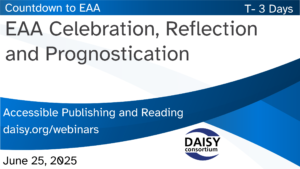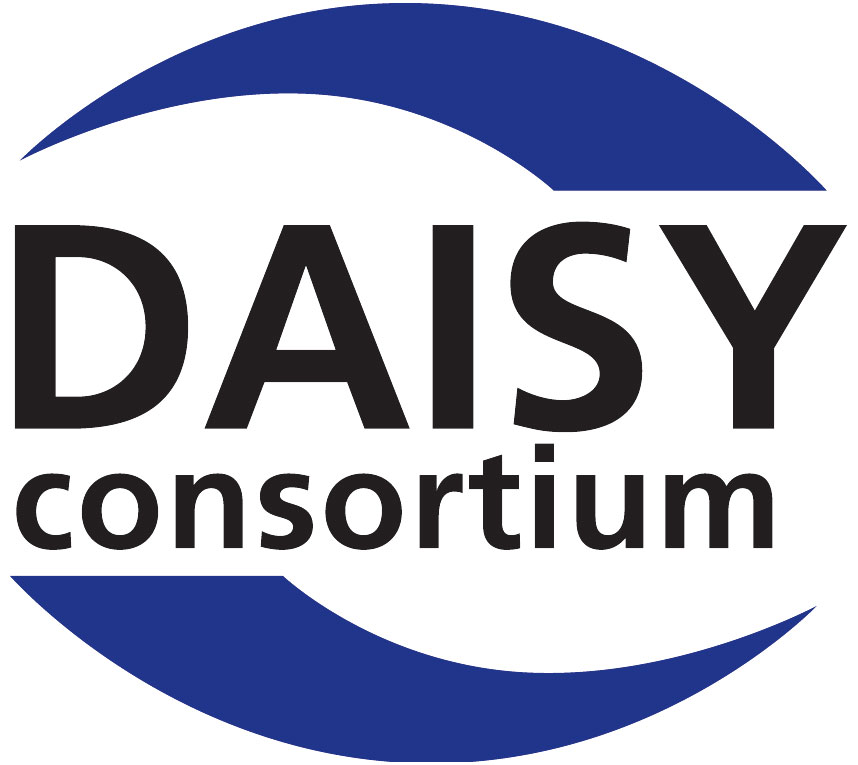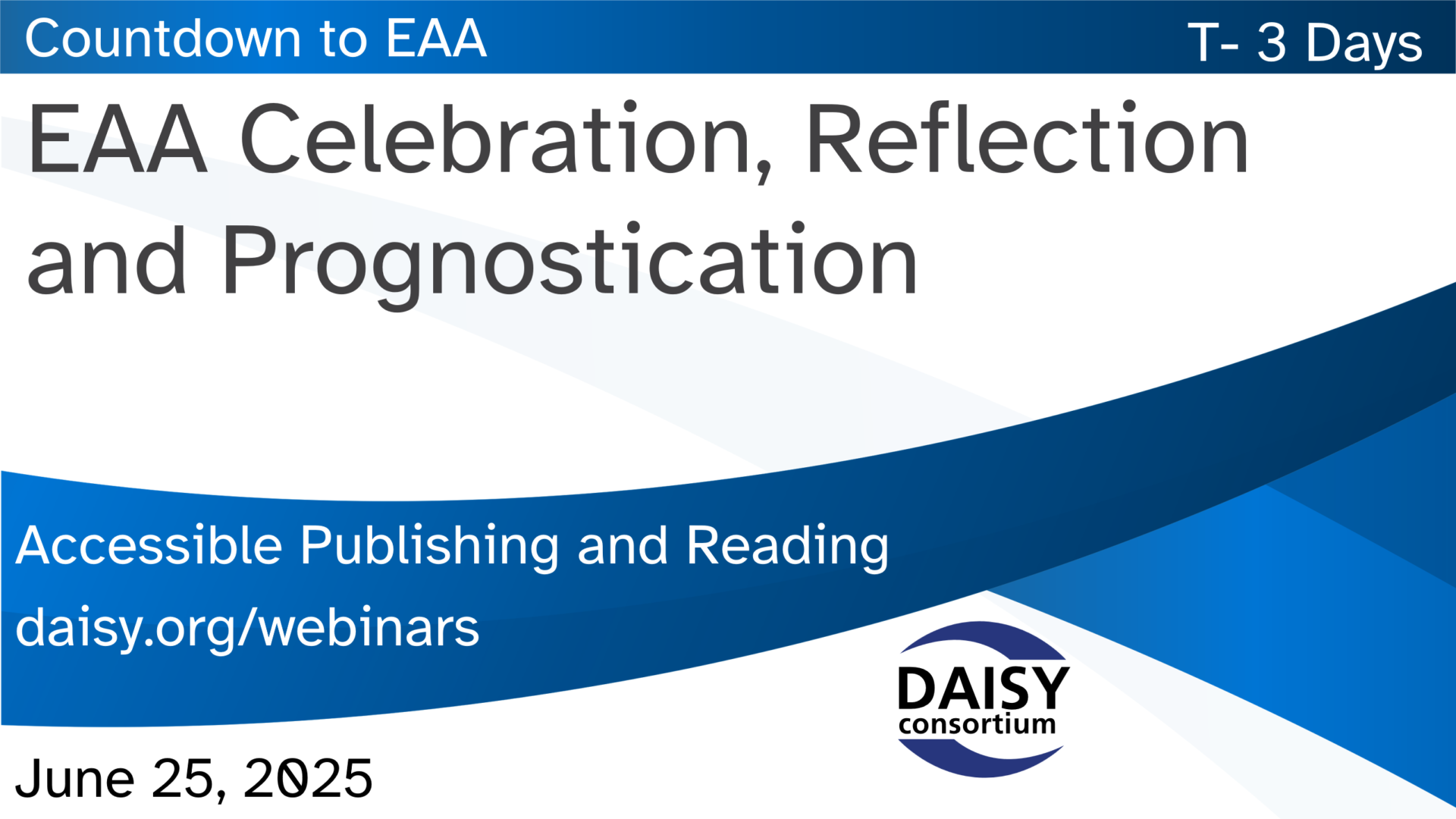EAA Celebration, Reflection and Prognostication, T-3 (W)
 In our series of free webinars June 25th saw a session that focused on celebrating and reflecting on all the good work that has gone into preparations for the EAA as well as looking forward to what still needs attention.
In our series of free webinars June 25th saw a session that focused on celebrating and reflecting on all the good work that has gone into preparations for the EAA as well as looking forward to what still needs attention.
This page contains:
Full Video of the Webinar
Speakers
- Richard Orme, The DAISY Consortium—host and chair
- Thomas Kahlisch, dzb Lesen
- Cristina Mussinelli, Fondazione LIA
- Rick Johnson, VitalSource
Session Overview
Richard Orme
Richard introduced the final webinar in the Countdown to the EAA Webinar series. This season has covered a huge variety of topics and this final episode gives us a chance to celebrate how far we’ve come, reflect on the journey so far, and look to the future for accessible publishing around the world.
Thomas Kahlisch: Working on a Dream
Thomas Kahlisch has spent many years working towards the “dream” of accessible content and spent some time reflecting on where we started out with the conversion of traditional printed books into accessible books and the work that was involved in this practice. The introduction of new technology made this process faster and more effective but in the beginning there were many software errors to contend with and remediation was inevitable. As a member of the DAISY Consortium, Thomas helped to improve this situation and technology and content became more accessible to all users around the world.
The dream has always been born accessible content and that is now a possibility. With the arrival of the EAA and the collaboration of teams and organizations, including DAISY, born accessible content is now something that readers can begin to expect and enjoy.
In Germany the industry began preparing in 2020, developing guidance and examples so that publishers can meet the challenge of producing mainstream accessible content. There are still challenges but by working together, the industry has proved that it can face these head on.
Cristina Mussinelli
Cristina spoke to us about the evolution of the EAA and the foundational instruments that have been created as well as focusing on some of the outstanding issues that still remain. The EAA’s focus on digital content means that all parts of the publishing supply chain bear responsibility for accessibility.
Since the inception of the EAA, Fondazione LIA have used a holisitic approach – establishing roles and responsibilities within the accessible digital publishing ecosystem for the successful creation of born accessible content. The industry has also focused on practical preparation via standards organizations – for specifications, platforms and metadata.
But this wasn’t enough – content creators also need the tools and instruments to aid their efforts and work on EPUBCheck, Ace by DAISY and InDesign etc has been very important. Work continues in this area but progress has been terrific so far.
Acknowledgement must be given to everyone who has helped and supported the publishing industry in this huge transition. We aren’t ready yet but there is much to be hopeful for – AI promises much, metadata is and will be used more widely, workflows are being adjusted. Challenges are anticipated with implementation, especially with backlist, the notion of disproportionate burden, penalties and outstanding user information. Some of these will be affected by location but by identifying them as areas of focus, it is hoped that publishers will concentrate their efforts on resolving them.
Rick Johnson
Rick described to us how seriously VitalSource has taken accessibility, working hard to provide the best user experience for a wide range of readers in over 37 countries. The EAA has had a huge impact on their work as it drives accountability for accessibility and has opened up many more capabilities for everyone. He reminded us of Alistair McNaught’s sage words:
The more mature digital legislation becomes, the less it requires the existence of disabled people to justify good practices…It shifts the focus from the abilties or disabilities of the user to the abilties of the person creating the product or service.
By shifting the focus to the vendor who provides the service and solving the problem of exactly how students find the resources they require. Many students try to solve these challenges themselves and the EAA will drive vendors to help them to do that.
Crucial to VitalSource’s approach are the 3 D’s in establishing best practice:
- Discovery – good metadata is vital for accessibility and a cornerstone of the EAA
- Disclosure – a key area for vendors who need to disclose what accessibility features are available in their digital content and their website.
- Debt – vendors and other supply chain partners need to continue to work on challenging areas as per their statements and audits. Good design and testing practices need to be in place.
Rick’s slide on the publishing metadata ecosystem perfectly explains the concept of 3 D’s and how important these are to VitalSource.
Related Resources
Presenter links:

